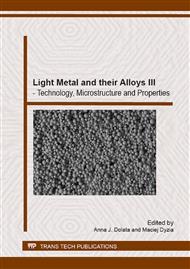[1]
P. Bartolotta, J. Barrett, T. Kelly, R. Smashey, The Use of Cast Ti-48Al-2Cr-2Nb in Jet Engines, J. of Met. 5 (1997) 48-76.
DOI: 10.1007/bf02914685
Google Scholar
[2]
H. Clemens, H. Kestler, Processing and Applications of Intermetallic γ-TiAl-Based Alloys, Adv. Eng. Mater. 9 (2000) 551-570.
DOI: 10.1002/1527-2648(200009)2:9<551::aid-adem551>3.0.co;2-u
Google Scholar
[3]
E. A. Loria, Gamma titanium aluminides as prospective structural materials, Intermetallics 8 (2000) 1339-1345.
DOI: 10.1016/s0966-9795(00)00073-x
Google Scholar
[4]
F. Appel, U. Brossmann et al., Recent Progress in the Development of Gamma Titanium Aluminide Alloys, Adv. Eng. Mater. 11 (2000) 699-719.
DOI: 10.1002/1527-2648(200011)2:11<699::aid-adem699>3.0.co;2-j
Google Scholar
[5]
X. Wu, Review of alloy and process development of TiAl alloys, Intermetallics 14 (2006) 1114-1122.
DOI: 10.1016/j.intermet.2005.10.019
Google Scholar
[6]
W. Szkliniarz, TiAl Intermetallic Alloys (in Polish), Silesian University of Technology House of Publishing, Gliwice, (2007).
Google Scholar
[7]
V. Güther, C. Rothe, S. Winter, H. Clemens, Metallurgy, Microstructure and Properties of Intermetallic TiAl Ingots, BHM 7 (2010) 325-329.
DOI: 10.1007/s00501-010-0580-9
Google Scholar
[8]
Lasalmonie, Intermetallics: Why is it so difficult to introduce them in gas turbine engines?, Intermetallics 14 (2006) 1123-1129.
DOI: 10.1016/j.intermet.2006.01.064
Google Scholar
[9]
M. Austin, T. J. Kelly, K. G. McAllister, J. C. Chesnutt, Aircraft Engine Applications for Gamma Titanium Aluminide, Structural Intermetallics 1997, Warrendale, 1997, 413-425.
Google Scholar
[10]
Rugg, The Current Status of Titanium Alloy Use in Aero-Engines, Ti-2003 Science and Technology, WILEYVCH Verlag GmbH & Co. KGaA, Weinheim, 2004, 2727-2735.
Google Scholar
[11]
Roth-Fagaraseanu, F. Appel, TiAl – New Opportunity in the Aerospace Industry, Ti-2003 Science and Technology, WILEY-VCH Verlag GmbH & Co. KGaA, Weinheim, 2004, 2899-2906.
Google Scholar
[12]
Appel, J. D. H. Paul, M. Oehring, Gamma Titanium Aluminide Alloys: Science and Technology, Wiley-VCH Verlag GmbH & Co. KGaA, Weinheim (2011).
DOI: 10.1002/9783527636204
Google Scholar
[13]
W. Szkliniarz, A. Szkliniarz, Quantitative Characterization of Microstructure of Ti-47Al-2W-0. 5Si Alloy after Melting in Vacuum Induction Furnace, Solid State Phenom. 197 (2013) 113-118.
DOI: 10.4028/www.scientific.net/ssp.197.113
Google Scholar
[14]
C. E. Wen, C. Q. Chen, New microstructure-property approach: Quenching/ tempering treatment in gamma TiAl alloy, Scripta Metall. Mater. 8 (1997) 1283-1288.
DOI: 10.1016/0956-716x(95)00348-y
Google Scholar
[15]
D. Hu, R. R. Botten, Phase transformation in some TiAl-based alloy, Intermetallics 10 (2002) 701-715.
DOI: 10.1016/s0966-9795(02)00047-x
Google Scholar
[16]
X. Wu, D. Hu, Microstructural refinement in cast TiAl alloys by solid state transformations, Scripta Mater. 8 (2005) 731-734.
DOI: 10.1016/j.scriptamat.2004.12.021
Google Scholar
[17]
W. J. Zhang, G. I. Chen, E. Evangelista, Formation of a Phase in the Massive and Feathery g-TiAl Alloys during Aging in the Single a Field, Metall. Mater. Trans. 30 A (1999) 2591-2598.
DOI: 10.1007/s11661-999-0298-z
Google Scholar
[18]
W. J. Zhang, L. Francesconi, E. Evangelista, A novel heat treatment to develop very fine lamellar structure in cast gamma-base TiAl alloys, Mater. Lett. 27 (1996) 135-138.
DOI: 10.1016/0167-577x(95)00291-x
Google Scholar
[19]
R. V. Ramanujan, On the massive transformation in g-based titanium aluminides, J. Mater. Sci. 37 (2002) 2203-2214.
Google Scholar
[20]
A. Szkliniarz, W. Szkliniarz, Effect of cyclic heat treatment parameters on the grain refinement of Ti-48Al-2Cr-2Nb alloy, Mater. Charact. 60 (2009) 1158-1162.
DOI: 10.1016/j.matchar.2009.03.008
Google Scholar
[21]
J. Szala, Application of Computer-Aided Image Analysis for Quantitative Evaluation of Materials' Structure (in Polish), Silesian University of Technology House of Publishing, Gliwice, (2001).
Google Scholar


